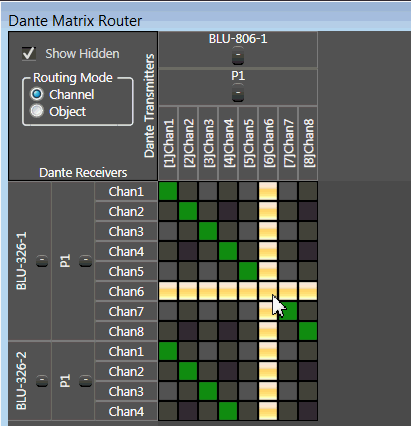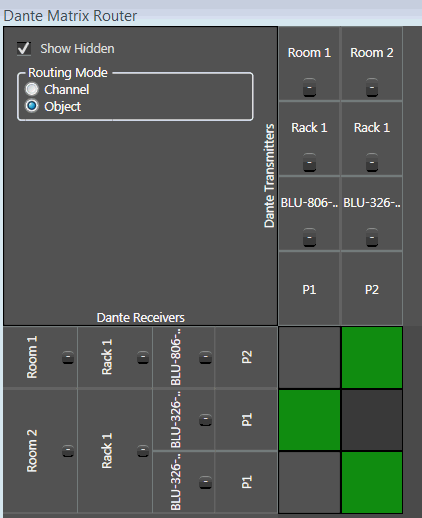

When Dante enabled devices (BLU-326DA, BLU-806DA or BLU-DA) are present in the venue, and Dante Input and Output processing objects have been added and properly configured with channels added, the Dante Matrix Router provides the means to route Dante audio from device to device.
NOTE: Dante Controller must be installed for the Dante Matrix Router to function. The Audinate Dante Controller can be downloaded HERE.
Audio Architect uses the DanteDiscovery Service from Audinate to discover the Dante devices in the network. This service gets installed in the Audio Architect machine when Dante Controller is installed. There is no NIC setup required from the user to talk to the Dante devices for Audio Architect routing.
The Dante Matrix Router button is located in the Route
Audio ribbon. In order to locate the Route Audio button you must be in room view.
This is found by clicking the Offline Design tab  and making sure the Room tab in the venue is selected
and making sure the Room tab in the venue is selected 
Transmitter channels are shown across the top, receiver channels are shown along the left-hand side. When the mouse is dragged across the matrix, there is a yellow cross-hatch pattern to indicate where the mouse is located. Click the box to make the connection. Boxes colored green indicate connected channels.
Levels may be expanded or contracted by clicking the small - or + box.

Show Hidden
When there are many Dante Transmitters and Dante Receivers, the matrix can get very large and cluttered. A cell such as a processing object (P1 for example) or a device (BLU-326DA-1 for example) can be hidden by right-clicking on it. This brings up a "Hide" option which will hide the cell. When cells are hidden, the Show Hidden box becomes un-checked. To view the hidden cells, check the Show Hidden box.

Channel: When checked, all available transmitting and receiving channels are displayed, allowing for precise channel routing.
Object: When checked, all channels from the indicated transmitting object are routed to all channels of the indicated receiving object. If Channel is selected again and individual channels are de-selected, the green box in Object Routing Mode will go gray. The Object Mode routing greatly simplifies routing when there are many channels to be routed.
Shown above is an example Dante Matrix Router with 3 devices. A single BLU-806DA is in one room while two BLU-326DA devices are in another room . The BLU-806DA has an 8-channel Dante transmitting object and a 2-channel receiving object.

One BLU-326DA (BLU-326DA-1) has a 2-channel transmitting object, and an 8-channel receiving object. The other BLU-326DA (BLU-326DA-2) has a single 4-channel receiving object.



Shown here is the example mentioned above, with the Dante signals routed via the Dante Matrix Router in the Channel Routing Mode. The Dante Transmitters are listed on the top of the matrix while the Dante Receivers are listed on the left of the matrix.
Displayed closest to the matrix are the channels
The layout is in hierarchical form - ie: closest to the matrix are the Channels then the Processing Objects, Device then Room.
Here is the above example with the Dante Matrix Router in Object Routing Mode.
